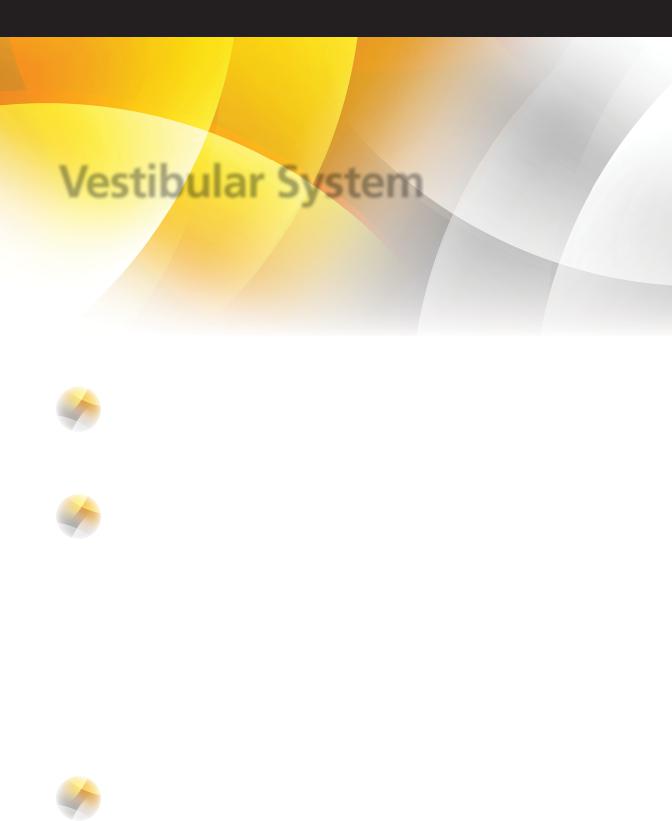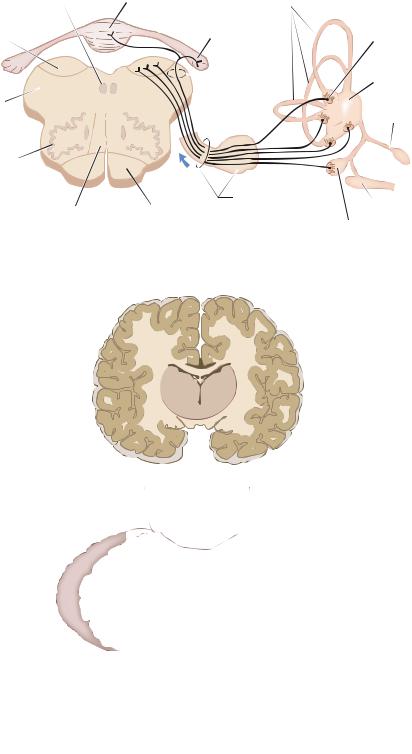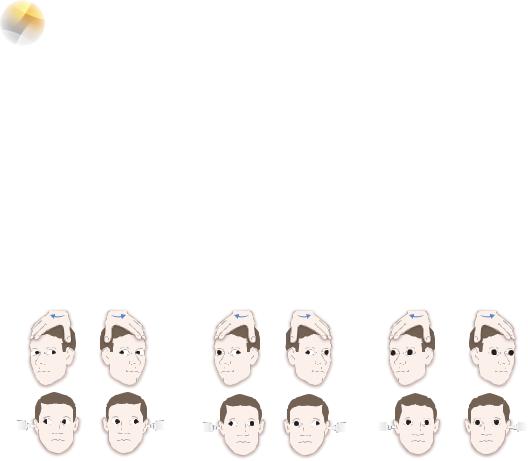
- •Objectives
- •Objectives
- •IX Congenital Malformations of the CNS
- •Objectives
- •VI Regeneration of Nerve Cells
- •Objectives
- •VI Venous Dural Sinuses
- •VII Angiography
- •Objectives
- •Objectives
- •IV Location of the Major Motor and Sensory Nuclei of the Spinal Cord
- •Case 6-1
- •Case 6-2
- •VII Conus Medullaris Syndrome (Cord Segments S3 to C0)
- •Objectives
- •Lesions of the Brainstem
- •Objectives
- •Objectives
- •VII The Facial Nerve (CN VII)
- •Objectives
- •IV Trigeminal Reflexes
- •Objectives
- •Objectives
- •IV Auditory Tests
- •Objectives
- •Objectives
- •VI Cortical and Subcortical Centers for Ocular Motility
- •VII Clinical Correlation
- •Objectives
- •IV Clinical Correlations
- •Objectives
- •Objectives
- •VI Cerebellar Syndromes and Tumors
- •Objectives
- •Objective
- •Objectives
- •I Major Neurotransmitters

C H A P T E R 1 3
Vestibular System
Objectives
1.Differentiate between static and kinetic (dynamic) equilibrium.
2.Describe the central and peripheral components of the vestibular pathways.
3.Compare and contrast postrotational and caloric vestibular nystagmus.
4.Describe the vestibulo-ocular reflexes in the unconscious patient.
IIntroduction. The vestibular system is served by the vestibulocochlear nerve (CN VIII),
an SSA nerve. Like the auditory system, the vestibular system is derived from the otic vesicle. The otic vesicle is a derivative of the otic placode, which is a thickening of the surface ectoderm. This system maintains posture and equilibrium and coordinates head and eye movements.
IIThe Labyrinth
A.Kinetic Labyrinth
1.Three semicircular ducts lie within the three semicircular canals (i.e., superior or anterior, lateral, and posterior).
2.These ducts respond to angular acceleration and deceleration of the head.
a.They contain hair cells in the crista ampullaris. The hair cells respond to endolymph flow.
b.Endolymph flow toward the ampulla (ampullopetal) or utricle (utriculopetal) is a stronger stimulus than is endolymph flow in the opposite direction.
B.Static Labyrinth
1.The utricle and saccule respond to the position of the head with respect to linear acceleration and the pull of gravity.
2.The utricle and saccule contain hair cells whose cilia are embedded in the otolithic membrane. When hair cells are bent toward the longest cilium (kinocilium), the frequency of sensory discharge increases.
III The Vestibular Pathways (Figures 13-1 and 13-2) consist of the
following structures:
A.Hair Cells of the Semicircular Ducts, Saccule, and Utricle are innervated by peripheral processes of bipolar cells of the vestibular ganglion.
B.The vestibular ganglion is located in the fundus of the internal auditory meatus.
104

|
|
|
|
|
|
|
Vestibular System |
105 |
MLF |
Nodulus |
|
|
Semicircular canals |
|
|||
Vestibular |
|
|
|
Flocculus |
|
|
|
|
nuclei |
|
|
|
|
Ampulla |
|
||
|
|
|
|
|
|
|
|
|
|
|
|
|
|
|
|
and crista |
|
Inferior |
|
|
|
|
Juxtarestiform |
|
Utricle |
|
|
|
|
|
|
|
|||
cerebellar |
|
|
|
|
body |
|
|
|
|
|
|
|
|
and macula |
|
||
peduncle |
|
|
|
|
|
|
|
|
|
|
|
Cerebello- |
|
|
|
||
|
|
|
|
|
Endolymphatic |
|||
|
|
|
|
|
||||
|
|
|
|
pontine angle |
|
|||
Inferior |
|
|
|
|
|
|
duct |
|
olivary |
|
|
|
|
|
|
|
|
nucleus |
|
|
|
|
|
|
|
|
Medial lemniscus |
Pyramid |
|
Vestibular nerve and |
Cochlear duct |
|
|||
|
ganglion in internal |
|
||||||
|
|
|
|
|
|
|
||
auditory meatus |
Saccule and macula |
|
Figure 13-1 Peripheral connections of the vestibular system. The hair cells of the cristae ampullares and the maculae of the utricle and saccule project through the vestibular nerve to the vestibular nuclei of the medulla and pons and the flocculonodular lobe of the cerebellum (vestibulocerebellum). MLF, medial longitudinal fasciculus.
Vestibular area of cerebral cortex
Thalamus
Ventral posterior nucleus
Vestibulothalamic tracts

 Oculomotor nucleus of CN III
Oculomotor nucleus of CN III
Midbrain |
Trochlear nucleus of CN IV |
|
Abducent nucleus of CN VI
MLF
 MLF
MLF
Nodulus of cerebellum
Juxtarestiform body |
|
|
|
Vestibular ganglion |
|
|
|
Vestibular nuclei
Cochlea
MLF
 Lateral vestibulospinal (Deiters') tract
Lateral vestibulospinal (Deiters') tract
Figure 13-2 The major central connections of the vestibular system. Vestibular nuclei project through the ascending medial longitudinal fasciculi (MLF) to the ocular motor nuclei and subserve vestibulo-ocular reflexes. Vestibular nuclei also project through the descending MLF and lateral vestibulospinal tracts to the ventral horn motor neurons of the spinal cord and mediate postural reflexes. CN, cranial nerve.

106Chapter 13
1.Bipolar neurons project through their peripheral processes to the hair cells.
2.Bipolar neurons project their central processes as the vestibular nerve (cranial nerve [CN] VIII) to the vestibular nuclei and to the flocculonodular lobe of the cerebellum.
C.Vestibular Nuclei
1.These nuclei receive input from:
a.The semicircular ducts, saccule, and utricle.
b.The flocculonodular lobe of the cerebellum.
2.The nuclei project fibers to:
a.The flocculonodular lobe of the cerebellum.
b.CNs III, IV, and VI through the medial longitudinal fasciculus (MLF).
c.The spinal cord through the lateral vestibulospinal tract.
d.The ventral posteroinferior and posterolateral nuclei of the thalamus, both of which project to the postcentral gyrus.
IV Vestibulo-ocular Reflexes are mediated by the vestibular nuclei, MLF, ocular motor nuclei, and CNs III, IV, and VI.
A.Vestibular (Horizontal) Nystagmus
1.The fast phase of nystagmus is in the direction of rotation.
2.The slow phase of nystagmus is in the opposite direction.
B.Postrotatory (Horizontal) Nystagmus
1.The fast phase of nystagmus is in the opposite direction of rotation.
2.The slow phase of nystagmus is in the direction of rotation.
3.The patient past-points and falls in the direction of previous rotation.
C.Caloric Nystagmus (Stimulation of Horizontal Ducts) in normal subjects
1.Cold water irrigation of the external auditory meatus results in nystagmus to the opposite side.
2.Warm water irrigation of the external auditory meatus results in nystagmus to the same side.
3.Remember the mnemonic COWS: cold, opposite, warm, same.
Cold H2O |
Cold H2O |
Cold H2O |
Cold H2O |
Cold H2O |
Cold H2O |
Brainstem intact |
MLF (bilateral) lesion |
Low brainstem lesion |
|||
Figure 13-3 Ocular reflexes in comatose patients. The external auditory meatus is irrigated with cold water. If the brainstem is intact, the eyes deviate toward the irrigated side. If the MLFs are transected, the eyes deviate toward the side of the abducted eye only. With lower brainstem damage, the eyes do not deviate from the midline. (Adapted with permission from Plum F, Posner GB. The Diagnosis of Stupor and Coma. 3rd ed. Philadelphia, PA: FA Davis; 1982:55.)

Vestibular System |
107 |
D.Test Results in Unconscious Subjects (Figure 13-3)
1.No nystagmus is seen in normal conscious subjects.
2.When the brain stem is intact, there is deviation of the eyes to the side of the cold irrigation in unconscious subjects.
3.With bilateral MLF transaction in unconscious subjects, there is deviation of the abducting eye to the side of the cold irrigation.
4.With lower brain stem damage to the vestibular nuclei, there is no deviation of the eyes in unconscious subjects.
CASE 13-1
A 60-year-old woman came to the clinic with complaints of progressive hearing loss, facial weakness, and headaches on the right side. She also said that she had become more unsteady in walking, with weakness and numbness of the right side of the face. No nausea or vomiting was noted. What is the most likely diagnosis?
Relevant Physical Exam Findings
●Reduced pain and touch sensation in right face
●Right facial weakness
●Absent right corneal reflex
●Hearing loss on right side
●No response to caloric test stimulation on right side
●Bilateral papilledema
Diagnosis
● Acoustic neuroma
